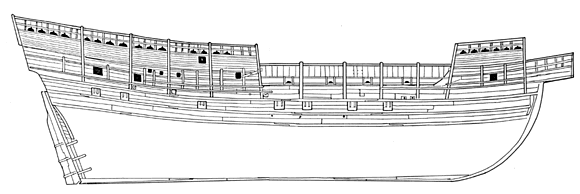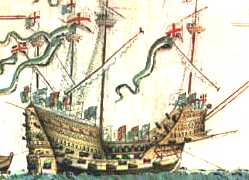|
The
Mary Rose was a devastating opponent, in the battle off
the French port of Brest in 1512 she crippled the enemy
flagship, and is said to have brought down her mainmast
with a single shot.
The
design and armament of the Mary Rose make her a true
precursor of the ship of the line. Henry VIII may
perhaps be justifiably considered to be the father of
the British Navy. It is unfortunate that her last
refit included reinforcing higher decks to carry yet
more armament and troops, and while making her even more formidable
in battle, this did nothing to prevent her rolling to
such an extent during a tight sea manoeuvre, to prevent
her lower gun-ports from allowing water to enter the
hull. Had these gun-ports been closed perhaps the
ship may not have sunk. However, the water did
enter the hull at sufficient rate to alter her balance
negatively - drawing her over and into the Solent waters
so fast that the crew had little chance to
escape.
The
Mary Rose was designed purely as a warship, she
apparently had no trading function and there are no
records of her ever taking part in trading voyages.
Her
complement and equipment show that she could fulfill a
number of roles, she could fight at sea, take part in
shore bombardment, or use the troops carried on board as
marines.

Mary
Rose side elevation
Considering
her fate, it is ironic the Mary Rose should be designed with watertight gun-ports.
These gun-ports allowed the Mary Rose to carry heavy
guns on her main deck, closer to the waterline,
maintaining her stability with increased firepower.

Long
Canon
While
the heavy guns provided the ship-smashing and shore
bombardment power, the Mary Rose also carried a variety
of weapons for use at closer quarters. These
ranged from swivel guns and handguns to longbows and the
ballock knives carried by individuals on board the ship.
The weapons carried on board the ship are an interesting
mixture of the latest technology, for instance the cast
bronze guns, and weapons of a much older design, like
the longbows and the wrought iron guns.

Mary Rose
artistic depiction
REFIT
HISTORY
The
Mary Rose had a keel length of 32m and a breadth of
11.66m. Her length at the waterline is estimated to have
been 38.5m and her draught 4.6m. The
surviving height of the ship is 13m, measured on the
starboard side at the aftercastle. The weight of the
ship increased during her lifetime, she was rated at 500
tons in 1512 and at 700 tons when she sank.
The
Mary Rose underwent two recorded major refits, one in
Portsmouth in 1527-28 and the other in the Thames around
1536, it is assumed her burden was increased to 700 tons
during this last refit. The ship appears to have
been skeleton built and carvel planked from her
inception. There is no available evidence to suggest
that she was converted from a clinker to a carvel built
ship during her career. The keel is constructed
from three pieces of elm, scarfed together and bolted to
the keelson which sits on top of the floor timbers.
PORSTMOUTH
HISTORIC DOCKYARD
Portsmouth
Historic Dockyard is a great day out on the South
Coast. Admission
tickets include entry to Mary Rose, HMS Victory, HMS
Warrior 1860, Action Stations, the Royal Naval Museum
and a Harbour Boat Tour!
Use
the links below to find out more about Portsmouth
Historic Dockyard and its many treasures.
| | | | |
TECHNICAL
SPECIFICATIONS
|



